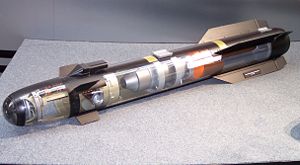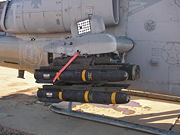AGM-114 Hellfire
| AGM-114 Hellfire | |
|---|---|
 A model of a Hellfire's components |
|
| Type | Air-to-surface and surface-to-surface missile |
| Place of origin | United States |
| Production history | |
| Manufacturer | Lockheed Martin |
| Specifications | |
| Length | 64 in (163 cm) |
| Diameter | 7 in (17.8 cm) |
|
|
|
| Warhead | High Explosive Anti-Tank (HEAT); 20 lb (9 kg) tandem anti-armor Metal augmented charge (MAC); 18 lb (8 kg) shaped-charge Blast Fragmentation |
|
|
|
| Engine | Solid-fuel rocket |
| Wingspan | 13 in (33 cm) |
| Operational range |
546 yd – 5 mi (500 m – 8 km) |
| Speed | Mach 1.3 (950 mph; 425 m/s) |
| Guidance system |
Semi-active laser homing millimeter wave radar seeker |
| Launch platform |
Rotary- and fixed-wing platforms, Unmanned aerial vehicle, tripods, ships, and ground vehicles |
The AGM-114 Hellfire is a multi-platform, multi-target United States modular missile system. The name comes from the fact that it was originally intended to be a helicopter-launched fire-and-forget weapon (HELicopter FIRE-and-forget). Initial problems with the TV-based guidance system forced designers to consider a laser-tracking system.
Description
The development of the Hellfire Missile System began in 1974 with the U.S. Army requirement for a "tank-buster", launched from helicopters to defeat armored vehicles.[1] Production of the AGM-114A started in 1982. The Development Test and Evaluation (DT&E) launch phase of the AGM-114B took place in 1984. The DT&E on the AGM-114K was completed in Fiscal Year (FY)93 and FY94. AGM-114M did not require a DT&E because it is the same as the AGM-114K except for the warhead. The early variants were laser guided with recent variants being radar guided. The Hellfire has matured into a comprehensive weapon system, one that can be deployed from rotary- and fixed-wing aircraft, naval assets, and land-based systems against a variety of targets.
Hellfire II, developed in the early 1990s is a modular missile system with several variants for maximum battlefield flexibility. Hellfire II's semi-active laser variants—AGM-114K high-explosive anti-tank (HEAT), AGM-114KII with external blast frag sleeve, AGM-114M (blast fragmentation), and AGM-114N metal augmented charge (MAC)—achieve pinpoint accuracy by homing in on a reflected laser beam aimed at the target from the launching platform. Predator and Reaper UAVs carry the Hellfire II, but the most common platform is the AH-64 Apache helicopter gunship, which can carry up to sixteen of the missiles at once. The AGM-114L, or Longbow Hellfire, is a fire-and-forget weapon: equipped with a millimeter wave (MMW) radar seeker, it requires no further guidance after launch and can hit its target without the launcher being in line of sight of the target. It also provides capability in adverse weather and battlefield obscurants. Each Hellfire weighs 47 kg / 106 pounds, including the 9 kg / 20 pound warhead, and has a range of 8,000 meters. As of late 2007, some 21,000 Hellfire IIs have been built since 1990, at a cost of about $68,000 each.
The Joint Common Missile (JCM) was to replace Hellfire II (along with the AGM-65 Maverick) by around 2011. The JCM was developed with a tri-mode seeker and a multi-purpose warhead that would combine the capabilities of the several Hellfire variants. In the budget for FY2006, the U.S. Department of Defense canceled a number of projects that they felt no longer warranted continuation based on their cost effectiveness, including the JCM, although some military and industry sources have produced data showing JCM is the most cost-effective way of adding performance on a timely basis across multiple platforms to meet projected threat growth. A possible new procurement for a JCM successor called the Joint Air to Ground Missile (JAGM) is under consideration. Due to the U.S. military's continuing need for a proven precision-strike aviation weapon in the interim until a successor to the JCM is fielded, as well as extensive foreign sales, it is likely the Hellfire will continue to remain in service for many years to come.
Combat history
Since being fielded, Hellfire missiles have proven their effectiveness in combat in Operation Just Cause in Panama, Operation Desert Storm, Operation Allied Force in Kosovo, Operation Enduring Freedom in Afghanistan, and most recently, Operation Iraqi Freedom—where they have been fired successfully from Apache and Cobra attack helicopters, Kiowa scout helicopters, and Predator unmanned aerial vehicles (UAVs). The Israeli Defence Forces have used them extensively against Palestinian targets.
Between 2001 and 2007, the U.S. has fired over 6,000 Hellfires in combat. The US military has found the missile effective in urban areas as the relatively small warhead reduces the risk of civilian casualties. The laser guidance allows a skilled operator to put a missile through the window of a building.
In 2008 the usage of the AGM-114N variant caused controversy in the United Kingdom when it was found out that these thermobaric munitions were added to the Royal Air Force (RAF) arsenal in secrecy. Thermobaric weapons have been condemned as "brutal" by human rights groups. The British Ministry of Defence circumvents this by calling the AGM-114N an "enhanced blast weapon".[2]
Launch vehicles and systems

- A-10 Thunderbolt II
- AH-1W Cobra
- AH-64 Apache
- Agusta A129 Mangusta
- Eurocopter Tiger ARH
- Combat Boat 90
- SH-60 Seahawk
- OH-58D Kiowa Warrior
- P 6297 Hellfire Missile Boat
- Portable Ground Launch System
- RAH-66 Comanche
- MQ-1B Predator
- MQ-9 Reaper
- UH-60 Blackhawk
- Westland WAH-64 Apache
- Cessna 208[3]
The system has been tested for use on the High Mobility Multipurpose Wheeled Vehicle (HMMWV) and the Improved TOW Vehicle (ITV). Test shots have also been fired from a C-130 Hercules (see photos below). Sweden and Norway use the Hellfire for coastal defense, and Norway has conducted tests with Hellfire launchers and aiming stations mounted on the Stridsbåt 90 coastal assault boat[4].
Operators
 Australia
Australia Egypt
Egypt France
France Greece
Greece Israel
Israel Iraq
Iraq Italy
Italy Kuwait
Kuwait Netherlands
Netherlands Norway
Norway Republic of China (Taiwan)
Republic of China (Taiwan) Singapore
Singapore South Korea
South Korea Sweden
Sweden Turkey
Turkey United Arab Emirates
United Arab Emirates United Kingdom
United Kingdom United States
United States
Variants
AGM-114A Basic Hellfire
- Target: Tanks, armored vehicles.
- Range: 8,000 m (8,750 yd)
- Guidance: Semi-active laser homing (SALH).
- Warhead: 8 kg (18 lb) shaped charge HEAT.
- Length: 163 cm (64 in)
- Weight: 45 kg (99 lb)
AGM-114B/C Basic Hellfire
- M120E1 low smoke motor.
- AGM-114B has electronic SAD (Safe/Arming Device) for safe shipboard use.
- Unit cost: $25,000
AGM-114D/E Basic Hellfire
- Proposed upgrade of AGM-114B/C with digital autopilot—not built.
AGM-114F Interim Hellfire
- Target: Tanks, armored vehicles.
- Range: 7,000 m (7,650 yd)
- Guidance: Semi-active laser homing.
- Warhead: 9 kg (20 lb) tandem shaped charge HEAT.
- Length: 180 cm (71 in)
- Weight: 48.5 kg (107 lb)
AGM-114G Interim Hellfire
- Proposed version of AGM-114F with SAD—not built.
AGM-114H Interim Hellfire
- Proposed upgrade of AGM-114F with digital autopilot—not built.
AGM-114J Hellfire II
- Proposed version of AGM-114F with lighter components, shorter airframe, and increased range—not built.
AGM-114K Hellfire II

- Target: All armored threats
- Range: 8.000 m (8,749 yd)
- Guidance:
- Semi-active laser homing
- Digital autopilot
- Electro-optical countermeasures hardening
- Target reacquisition after lost laser lock
- New electronic SAD
- Warhead: 9 kg (20 lb) tandem shaped charge HEAT
- Length: 163 cm (64 in)
- Weight: 45 kg (99 lb)
- Unit cost: $65,000
- Essentially the proposed AGM-114J w/ SAD
AGM-114L Longbow Hellfire
- Target: All armored threats
- Range: 8.000 m (8,749 yd)
- Guidance:
- Fire and forget
- Capability in adverse weather and battlefield obscurants
- Inertial guidance
- Millimeter wave radar seeker
- Home-on-jam anti-radiation mode
- Warhead: 9 kg (20 lb) tandem shaped charge high explosive anti-tank (HEAT)
- Length: 176 cm (69.2 in)
- Weight: 49 kg (108 lb)
AGM-114M Hellfire II
- Target: Bunkers, light vehicles, urban (soft) targets and caves
- Range: 8.000 m (8,749 yd)
- Guidance:
- Semi-active laser homing
- Warhead: Blast fragmentation/incendiary
- Weight: 48 kg (105 lb)
- Length: 163 cm (64 in)
AGM-114N Hellfire II
- Target: Enclosures, ships, urban targets, air defense units
- Range: 8.000 m (8,749 yd)
- Guidance:
- Semi-active laser homing
- Warhead: Metal augmented charge (MAC) (Thermobaric)
- Weight: 48 kg (105lb)
- Length: 163 cm (64 in)
AGM-114P Hellfire II
- Version of AGM-114K optimized for use from UAVs flying at high altitude.
Rocket motor

- Contractor: Alliant Techsystems
- Designation:
- M120E3 (Army)
- M120E4 (Navy)
- Main features:
- Qualified minimum smoke propellant
- Rod and tube grain design
- Neoprene bondline system
- Performance:
- Operating temperature: −43 °C to 63 °C (−45 °F to 145 °F)
- Storage temperature: −43 °C to 71 °C (−45 °F to 160 °F
- Service life: 20+ years (estimated)
- Technical data:
- Weight: 14.2 kg (31.3 lb)
- Length: 59.3 cm (23.35 in)
- Diameter: 18 cm (7.0 in)
- Case: 7075-T73 aluminum
- Insulator: R-181 aramid fiber-filled EPDM
- Nozzle: Cellulose phenolic
- Propellant: Minimum smoke cross linked double based (XLDB)
Photos
See also
- Brimstone missile
- AGM-169 Joint Common Missile
- Euromissile HOT
- PARS 3 LR
- List of missiles
- U.S. Army Aviation and Missile Command
- AN/PAQ-1
- Direct Attack Guided Rocket
References
- ↑ Globalsecurity.org AGM-114 page
- ↑ Smith, Michael (2008-06-22). "Army 'vacuum' missile hits Taliban". Times Online. Retrieved on 2008-06-22.
- ↑ [1]
- ↑ Norwegian article about the experimental deployment of Hellfire missiles on coastal patrol boats (from the official web site of the Norwegian Armed Forces)
External links
- more detailed description on FAS
- Lockheed Martin - Hellfire II
- Lockheed Martin - Longbow Hellfire
- Designation Systems
- Global Security
- Archived copy of Navy Fact File
- Janes.com
- Hellfire Detailed Description and Images
|
|||||
|
||||||||||||||||||||||||||||||||||